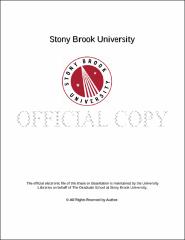| dc.identifier.uri | http://hdl.handle.net/11401/77620 | |
| dc.description.sponsorship | This work is sponsored by the Stony Brook University Graduate School in compliance with the requirements for completion of degree. | en_US |
| dc.format | Monograph | |
| dc.format.medium | Electronic Resource | en_US |
| dc.language.iso | en_US | |
| dc.publisher | The Graduate School, Stony Brook University: Stony Brook, NY. | |
| dc.type | Dissertation | |
| dcterms.abstract | The Drosophila anterior/posterior segmentation pathway is a robust system for investigating transcription regulation in an in vivo setting. Runt, the founding member of the Runx family of transcription factors, is a master regulator of gene expression during development. Distinct combinations of Runt and other pair-rule factors act at two recently identified cis-regulatory modules (CRMs) DESE and PESE, to generate the initial 14-stripe sloppy paired 1 (slp1) pattern (Swantek & Gergen, 2004; Prazak et al, 2010). Each CRM alone drives a subset of the slp1 pattern, but their combined action recapitulates early expression of slp1 in a manner not expected from simple addition of their respective patterns. Runt is key in mediating these “non-additive†interactions, and its presence determines which enhancer regulates activity of the promoter in a particular cell context. I investigated if Runt mediates non-additive interactions for the segment polarity gene, wingless (wg). Experiments utilizing reporter constructs containing two putative pair-rule regulated CRMs for wg and double in situ hybridization confirm that the two CRMs are active at the blastoderm stage and moreover, respond to pair-rule regulation. Each CRM drives expression of all 14 wg stripes, however wg2946 also drives ectopic expression posterior to the odd-numbered stripes, and the even-numbered stripes are weak. A composite wg3911/2946 reporter recapitulates the endogenous wg pattern. Pair-rule loss and gain of function experiments reveal both similarities and differences to slp1 regulation. This detailed functional analysis was complemented by efforts to investigate the physical basis of CRM/promoter interactions in different genetic backgrounds. 4C-seq and ChIP experiments can confirm if Runt mediates physical interactions and influences modENCODE identified enhancer signatures. Overall, these experiments provide a second example of the Runt-dependent regulation of enhancer promoter interaction and further suggest that the non-additive integration of inputs from different CRMs is a widespread aspect of regulating transcription in animal systems. | |
| dcterms.available | 2017-09-20T16:53:02Z | |
| dcterms.contributor | Sirotkin, Howard | en_US |
| dcterms.contributor | Gergen, J. Peter | en_US |
| dcterms.contributor | Martin, Benjamin | en_US |
| dcterms.contributor | Gingeras, Thomas | en_US |
| dcterms.contributor | Rushlow, Christine. | en_US |
| dcterms.creator | Bell, Kimberly | |
| dcterms.dateAccepted | 2017-09-20T16:53:02Z | |
| dcterms.dateSubmitted | 2017-09-20T16:53:02Z | |
| dcterms.description | Department of Genetics. | en_US |
| dcterms.extent | 108 pg. | en_US |
| dcterms.format | Monograph | |
| dcterms.format | Application/PDF | en_US |
| dcterms.identifier | http://hdl.handle.net/11401/77620 | |
| dcterms.issued | 2015-12-01 | |
| dcterms.language | en_US | |
| dcterms.provenance | Made available in DSpace on 2017-09-20T16:53:02Z (GMT). No. of bitstreams: 1
Bell_grad.sunysb_0771E_12652.pdf: 8705692 bytes, checksum: d586a6c7ec83a633a507ce6d9c335e01 (MD5)
Previous issue date: 1 | en |
| dcterms.publisher | The Graduate School, Stony Brook University: Stony Brook, NY. | |
| dcterms.subject | blastoderm, cis-regulatory module, enhancer-promoter interaction, transcription, wingless | |
| dcterms.subject | Genetics | |
| dcterms.title | Regulation of wingless transcription in the Drosophila blastoderm embryo | |
| dcterms.type | Dissertation | |

